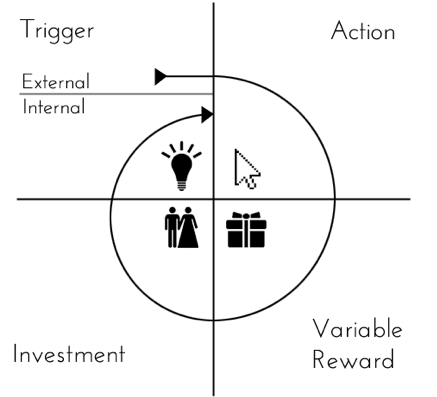Product people possess the creative and ethical wherewithal to persuade users to behave in ways that materially improve their lives – using our powers for good. The secret is to understand that, if we want to connect our product’s use to a repetitive consumer habit, we must identify the internal trigger that drives consumer behavior. Understanding this crucial piece can explain how software products become so habit forming.
In this episode, Sean and Joe chat with Nir Eyal, keynote speaker at ITX’s Product Momentum: Beyond the Features product conference (June 19-21), whose work on Behavioral Design has brought him and us to the intersection of psychology, technology, and business. The goal of his work is to help product people design the products and services that consumers want to use and that drive positive, habit-forming behaviors. Nir combines a gift for observation with an uncanny awareness to convert life experiences into problem statements that ultimately lead to research, learning, and discovery.
The Hook Model
Nir developed The Hook Model as a way to understand more deeply the technology behind how companies like Facebook, Twitter, Instagram, and others design products that become so habit-forming. The model represents a four-step process that product builders embed into their creations that subtly influence consumer behavior. The habits that form create the hook, “which is critical to the survival of many products” Nir says.

The most important step is attaching your product’s use to a consumer habit – finding that internal trigger, the itch that needs scratching. That’s the first domino to fall, leading to the model’s three succeeding steps: Action, Reward, and Investment. The goal, Nir says, is to create the habit between the internal trigger and the regular – if not frequent – use of your product. But not just any product, he adds.
We need to be thinking, “What if we could design our products and services in a way that could help people form healthy habits in their lives?”
Designing for Habits – Why It’s a Better Way
Nir makes clear at the outset that not every product or service is (or needs to be) habit-forming. That said, every product that needs a habit also needs a hook.
“Lots of businesses deliver value to their customers without becoming a habit,” Nir adds. “The problem is if you don’t have a habit, you need to find some other competitive advantage. Without it, you’re constantly fighting on price and features. To get out of that constant battle, focusing on habits can be a huge competitive advantage.”
But if my product isn’t necessarily habit forming, how do I create the hook that leads to greater consumer engagement?
Content and Community – “Bolting On” Habit-forming Behaviors
E-commerce sites are so eager to help you complete your online order, to get in and check out as quickly as possible. Sure, they offer a “continue shopping” opportunity, but most sites focus on closing the sale. Nir says that’s a mistake, a lost opportunity. Instead, he adds, we need to figure out how to get people to engage with us more frequently by bolting on these habits.
One way to do so is through content. Consuming the products we build and sell may not be a recurring behavior, Nir says, using the purchase of cookware as an example. But consuming content about new and interesting recipes, techniques, and cuisine is a recurring behavior. Creating positive, habit-forming behaviors around content consumption is a way to keep our audience engaged with our products.
Companies need to learn not only what makes consumers click, but also what makes them tick. – Nir Eyal, Hooked
Another way to set the hook is through community, Nir adds. “If you can build some kind of community around your product – even if it’s not used all that frequently – the community aspect of that product can keep people engaged [with the product and with one another] so that again the result of each engagement is monetization at some point.”
If you aren’t able to attend ITX’s Product Momentum: Beyond the Features product conference (June 19-21), be sure to catch the latest ITX Product Momentum Podcast episode with Nir Eyal: Product Design Driving Positive Behaviors, where you’ll hear Nir–
- Explain how product designers manipulate consumer behavior in two very different ways, through persuasion (helping consumers do things they want to do) and coercion (getting people to do things they don’t want to do).
- Discuss his new book, Indistractable, in which he helps us understand that we become distracted because we are looking for a distraction – i.e., some opportunity to escape the discomfort in our lives.
- Describe the 4-step Hooked model in detail, specifically the Trigger, Action, Reward, and Investment – and learn more about Reward in terms of the Tribe, the Self, and the Hunt.
* The Hook Model. Used with permission. Hooked: How To Build Habit-Forming Products. © 2014 Nir Eyal, with Ryan Hoover. The Penguin Group. New York, New York.
Nir’s Book recommendations:
Suggestible You: The Curious Science of Your Brain’s Ability to Deceive, Transform, and Heal, by Erik Vance.
Lost Connections: Uncovering the Real Causes of Depression – and the Unexpected Solutions, by Johann Hari.
Where you can catch Nir:
Nir’s top articles.
NirandFar podcast.
Hooked: How to Build Habit-Forming Products, by Nir Eyal with Ryan Hoover.
Indistractable: How to Control Your Attention and Choose Your Life.
Join us on June 21 to hear Nir speak at the Product Momentum: Beyond the Features product conference, in Rochester, NY.



